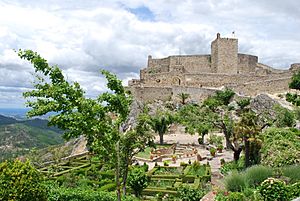Battle of Marvão facts for kids
Quick facts for kids Battle of Marvão |
|||||||
|---|---|---|---|---|---|---|---|
| Part of the Spanish invasion of Portugal | |||||||
 Castelo de Marvão |
|||||||
|
|||||||
| Belligerents | |||||||
| Commanders and leaders | |||||||
| Strength | |||||||
| 500 | 4,000 | ||||||
| Casualties and losses | |||||||
| Light | Heavy | ||||||
The Battle of Marvão was an important fight that happened in late 1762. It was part of a bigger war where Spain and France tried to invade Portugal. This battle was also part of the Fantastic War and the Anglo-Spanish War. A large Spanish army attacked the castle town of Marvão. But, a brave group of British and Portuguese soldiers, led by Captain Thomas Browne, fought them off and won!
Contents
The Battle of Marvão
Why the Battle Happened
Earlier in 1762, Spain had tried to invade Portugal twice, but both attempts failed. Around this time, France sent 10,000 soldiers to help Spain. Great Britain also sent about 8,000 soldiers to help Portugal. These British troops were led by John Burgoyne and General George Townshend.
Peace talks were happening between France and Great Britain. Spain wanted to win some battles to have more power in these talks. So, they decided to launch a surprise attack in late autumn. This was unusual because armies usually waited until spring to start big campaigns.
However, the commander in Portugal, Count Lippe, was ready. He had already made sure that important forts had British officers and strong Portuguese soldiers. The Spanish army split into several groups, each attacking a different target. Marvão was one of these targets. Spain hoped to capture and hold it.
The Fight at Marvão Castle
The Castle of Marvão was very important. It sat high up on a granite rock near the Tagus River, right on the border. Taking this castle would make it easier for the Spanish to cross the Tagus River.
About 500 soldiers defended the castle. Their leader was Captain Thomas Browne. He commanded a company of British soldiers from the 83rd Regiment. He also had a small group of Portuguese soldiers, local fighters, and some cannons.
A large Spanish army of 4,000 to 5,000 men came closer. The people living in Marvão were very scared and wanted to surrender. But Captain Browne was firm and kept everyone strong. He thought the Spanish would try a long siege (surrounding the castle to starve out the defenders).
However, he was surprised when the Spanish attacked directly. The castle was in a very strong defensive position. The Spanish tried to climb up the easier southeast side of Marvão. Captain Browne quickly sent more soldiers from the main part of the castle to that side.
The British and Portuguese soldiers started firing their muskets and cannons at the Spanish attackers. The Spanish tried to throw themselves against the walls. But many of their climbing ladders were too short to reach the top. The defenders easily pushed them back. The Spanish lost many soldiers from accidents, as well as from cannon and musket fire. The Spanish commander realized his surprise attack had failed. He also saw that the castle was very well defended. He was not ready for a long siege, so he called off the attack. His army retreated the next day.
What Happened Next
Another Spanish attack was stopped at Ouguela, which was another small fort. The Portuguese soldiers there were also ready. The Spanish were forced to leave with many losses.
On November 19, the soldiers from Marvão and Ouguela joined forces. They then raided and captured the Spanish town of La Codosera. The strong resistance the Spanish met in these small places showed them that taking the Alentejo region would be very difficult. The late time of year also made things hard. Many Spanish soldiers were getting sick, and they didn't have enough supplies.
On November 15, the entire Spanish force began to retreat. By November 22, Spain asked for a truce, which is a stop to the fighting.
See also
 In Spanish: Batalla de Marvão para niños
In Spanish: Batalla de Marvão para niños

